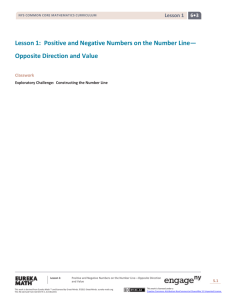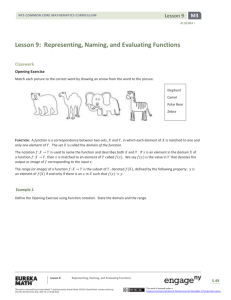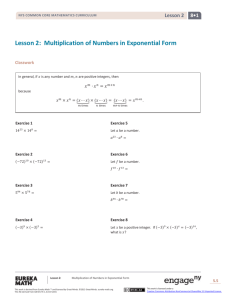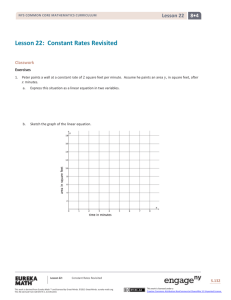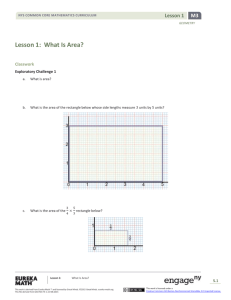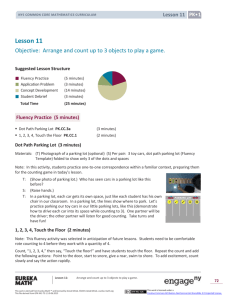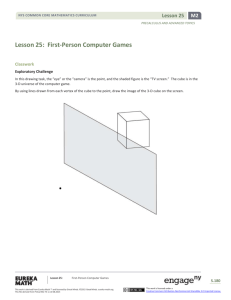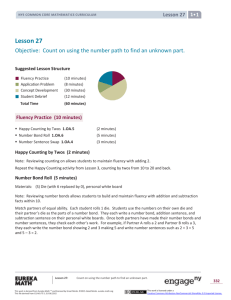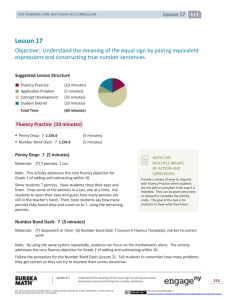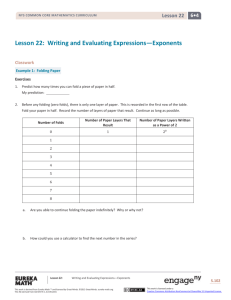Lesson 5: Day 2 of Lesson 4
advertisement
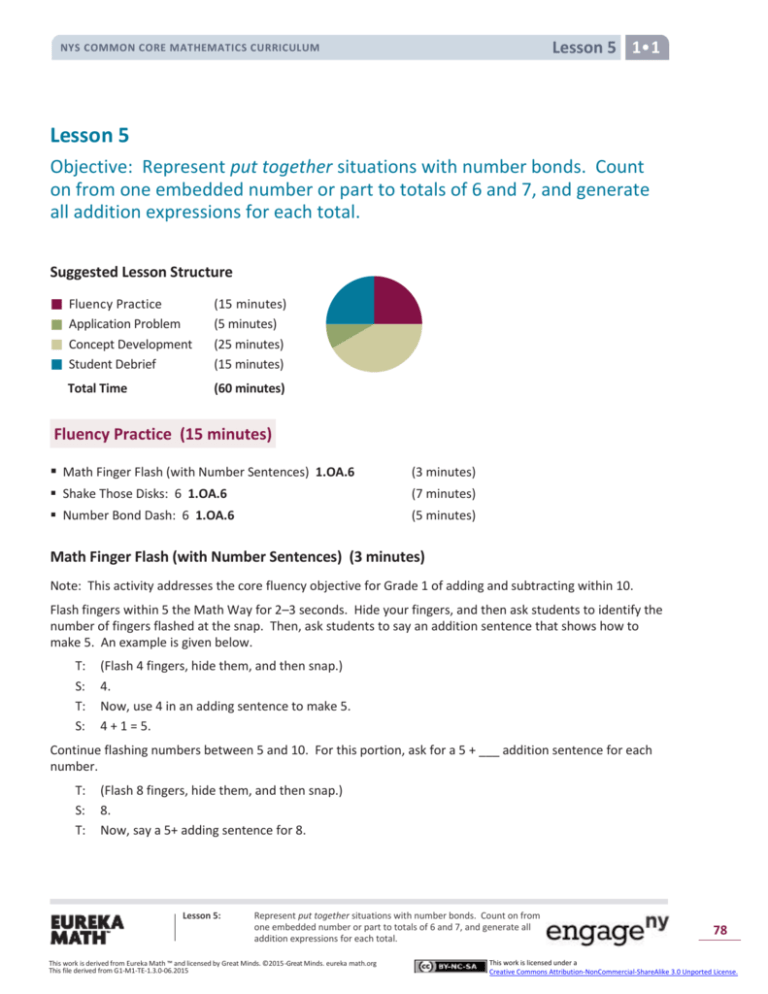
Lesson 5 1•1 NYS COMMON CORE MATHEMATICS CURRICULUM Lesson 5 Objective: Represent put together situations with number bonds. Count on from one embedded number or part to totals of 6 and 7, and generate all addition expressions for each total. Suggested Lesson Structure Fluency Practice Application Problem Concept Development Student Debrief Total Time (15 minutes) (5 minutes) (25 minutes) (15 minutes) (60 minutes) Fluency Practice (15 minutes) Math Finger Flash (with Number Sentences) 1.OA.6 (3 minutes) Shake Those Disks: 6 1.OA.6 (7 minutes) Number Bond Dash: 6 1.OA.6 (5 minutes) Math Finger Flash (with Number Sentences) (3 minutes) Note: This activity addresses the core fluency objective for Grade 1 of adding and subtracting within 10. Flash fingers within 5 the Math Way for 2–3 seconds. Hide your fingers, and then ask students to identify the number of fingers flashed at the snap. Then, ask students to say an addition sentence that shows how to make 5. An example is given below. T: S: T: S: (Flash 4 fingers, hide them, and then snap.) 4. Now, use 4 in an adding sentence to make 5. 4 + 1 = 5. Continue flashing numbers between 5 and 10. For this portion, ask for a 5 + ___ addition sentence for each number. T: S: T: (Flash 8 fingers, hide them, and then snap.) 8. Now, say a 5+ adding sentence for 8. Lesson 5: Represent put together situations with number bonds. Count on from one embedded number or part to totals of 6 and 7, and generate all addition expressions for each total. This work is derived from Eureka Math ™ and licensed by Great Minds. ©2015 -Great Minds. eureka math.org This file derived from G1-M1-TE-1.3.0-06.2015 78 This work is licensed under a Creative Commons Attribution-NonCommercial-ShareAlike 3.0 Unported License. Lesson 5 1•1 NYS COMMON CORE MATHEMATICS CURRICULUM S: T: 5 + 3 = 8. (Hold up 5 and 3 as students say the equation.) Shake Those Disks: 6 (7 minutes) Materials: (S) Per set of partners: 6 disks (e.g., counters, two-color beans, or pennies), 1 shake those disks 6 board (Fluency Template 1) Note: This activity addresses the core fluency objective for Grade 1 of adding and subtracting within 10. Break students into partners. Give each set of partners 6 disks. Instruct them to take turns as the Shaker and the Recorder. The Shaker shakes the disks and tosses them on the table. The Recorder then records the roll on the Shake Those Disks board. (For example, if the Shaker rolls 4 red and 2 white, the Recorder puts an X on the graph above the 4 and 2 number bond.) Number Bond Dash: 6 (5 minutes) Materials: (T) Stopwatch or timer (S) Number bond dash 6 (Fluency Template 2), marker to correct work Note: By using the same system, the Number Bond Dash, students focus on the mathematics, rather than figuring out the routine. Unlike most Number Bond Dashes, students will not have a chance to improve their scores on Day 2 during this round, as Topic B progresses through exploration of decompositions of 6, 7, 8, 9, and 10, giving students practice with a new number each day. Distribute the Dash to students, face down. Instruct students to flip their papers when you say, “Go!” and complete as many number bonds as they can in 90 seconds. Assure them it is okay if they run out of time before they finish. Tell them if they finish, they can practice counting to 20 on the back of their papers, starting with the number 5. Change the counting sequence to meet the needs of students, in later lessons. As you choose a counting sequence, consider counting forward or back by different numbers. When counting forward, it is beneficial to change the starting number. T: T: T: T: (Set the timer for 90 seconds.) On your mark, get set, GO! (Press start.) (When the timer goes off, tell students to put down their pencils and grab a marker to correct their work.) When you get an answer correct, put a check mark on the problem number. If you need to change your answer, just change it with your marker. (Read the number bonds aloud, starting with Problem 1.) When you are finished checking all the problems, write the number you got correct in the star-like shape on top. Lesson 5: Represent put together situations with number bonds. Count on from one embedded number or part to totals of 6 and 7, and generate all addition expressions for each total. This work is derived from Eureka Math ™ and licensed by Great Minds. ©2015 -Great Minds. eureka math.org This file derived from G1-M1-TE-1.3.0-06.2015 79 This work is licensed under a Creative Commons Attribution-NonCommercial-ShareAlike 3.0 Unported License. Lesson 5 1•1 NYS COMMON CORE MATHEMATICS CURRICULUM Application Problem (5 minutes) Marcus had 6 pieces of candy. He decided to give some to his mother and keep some for himself. Use pictures and numbers to show two ways that Marcus could have split up 6 pieces of his candy. Note: This problem is designed as a bridge from the previous lesson’s focus on decompositions of 6, reminding students that they can break apart numbers in more than one way. Concept Development (25 minutes) Materials: (T) Number bond on the white board, markers, chart to record decompositions of 7 (S) 5-group cards (Template 1), 7 children picture card (Template 2), scissors, glue stick, a sheet of blank paper for Student Debrief Have students sit in a big semi-circle facing the number bond on the board. Distribute 5-group cards to each pair of students. Tell them they will be using the cards to show different ways to make 7. Instruct students to put their cards in order from smallest to largest. Using students as actors, choose a group of students who have different attributes that represent decompositions of 7, and have them line up at the board (e.g., 6 with short hair, 1 with long hair). Note: Be sure to encourage the actors themselves to participate in the mathematics of the lesson. MP.2 T: S: T: T: S: T T: S: T: T: S: T: T: T: S: How many students are here? 7. (Write 7 in the total box of the number bond.) What does this 7 represent? (Point to the 7.) (Responses may vary.) The kids. The 7 in our whole represents the number of students. (Label the whole with the word students.) There’s 1 student up here who has something different from the rest! What is it? 1 has long hair! (Write 1 in the number bond.) What does this 1 represent? (Point to the 1.) Long hair. The 1 represents the part of our students with long hair, so I am going to label this part long hair. (Write long hair next to the part with the number 1.) Show 1 with your 5-group card using the dot side, and put it in front of you. If [Student 1 with long hair] has long hair, what about the rest of these students? They have short hair. Lesson 5: Represent put together situations with number bonds. Count on from one embedded number or part to totals of 6 and 7, and generate all addition expressions for each total. This work is derived from Eureka Math ™ and licensed by Great Minds. ©2015 -Great Minds. eureka math.org This file derived from G1-M1-TE-1.3.0-06.2015 80 This work is licensed under a Creative Commons Attribution-NonCommercial-ShareAlike 3.0 Unported License. Lesson 5 1•1 NYS COMMON CORE MATHEMATICS CURRICULUM T: S: T: T: S: T: T: T: S: T: T: S: T: S: T: S: T: T: S: T: S: T: S: How many students have short hair? 6. (Write 6 in the number bond.) How should I label this part? Short hair. Yes. Six represents the number of students with short hair. (Write short hair next to the part with the number 6.) Now, show 6 with your 5-group card using the dot side, right next to your first card. What’s the best strategy to find out how many students there are altogether? (Responses may vary.) Count on from 1. Point with me to keep track as we count on from 1. (Gesture around the group of 1, and then count on with the class by touching the 6 students on the head; have them sit down as they are counted.) Now, it’s your turn to count on. Flip your 1 dot card to show the number 1. Then, count on from 1. Be sure to touch and count! (Count on from 1 to 7, pointing to each dot.) What are the two parts that make 7? 1 and 6. Say the number sentence that makes 7. (Point to each box in the number bond as students respond.) NOTES ON 1 + 6 = 7. MULTIPLE MEANS (Record this on the chart.) FOR ACTION AND Say the number sentence starting with the students EXPRESSION: with short hair. Once students have shown how to 6 + 1 = 7. make 7 with their 5-group cards, call on Say the number sentence starting with the total. a volunteer to come fill in the number bond on the board. See if other 7 = 1 + 6. volunteers can write the number Say the number sentence starting with the total, but sentence(s) that go along with the 5flip the parts this time. group cards and number bond on the 7 = 6 + 1. board. Maybe have another volunteer 1 Continue this process with the other decompositions of 7. Keep the same actors, but rearrange them to show different decompositions of 7 (e.g., 2 sit, 5 stand; 3 smiling, 4 frowning). Review zero if necessary. Lesson 5: illustrate the number bond. Providing a variety of ways for students to respond allows them to make choices and engage when they know they will be successful at the task. Represent put together situations with number bonds. Count on from one embedded number or part to totals of 6 and 7, and generate all addition expressions for each total. This work is derived from Eureka Math ™ and licensed by Great Minds. ©2015 -Great Minds. eureka math.org This file derived from G1-M1-TE-1.3.0-06.2015 81 This work is licensed under a Creative Commons Attribution-NonCommercial-ShareAlike 3.0 Unported License. Lesson 5 1•1 NYS COMMON CORE MATHEMATICS CURRICULUM Problem Set (10 minutes) Distribute the picture card with seven students in a classroom, the Problem Set, and 5-group cards for each student. Similar to Lesson 4, students record all of the decompositions of 7 (in number bonds and as expressions) on their Problem Set as they use the 5-group cards to count on, just as they did during the Concept Development. Judge to determine whether students should complete this as whole group, in small groups, or independently. Students should do their personal best to complete the Problem Set within the allotted 10 minutes. For some classes, it may be appropriate to modify the assignment by specifying which problems they work on first. Some problems do not specify a method for solving. Students solve these problems using the RDW approach used for Application Problems. Student Debrief (15 minutes) Lesson Objective: Represent put together situations with number bonds. Count on from one embedded number or part to totals of 6 and 7, and generate all addition expressions for each total. The Student Debrief is intended to invite reflection and active processing of the total lesson experience. Have students bring their Problem Set to the meeting area. Ask them to cut out their number bonds from the sheet, and place them in an order that is numerical (students may begin with 7 + 0, then 6 + 1, 5 + 2, etc., or 0 + 7, 1 + 6, 2 + 5, etc.). T: S: T: Talk with your partner about how you put your number bonds of 7 in an order based on the numbers. Does your way of ordering look the same as or different from your partner's? (Responses may vary.) Let’s write all of the number bonds of 7. (Record all of the number bonds of 7 on a chart beginning with 7 and 0, and call on students to help write the expressions.) Have the students glue their number bonds in order, starting with 7 and 0, on a blank sheet of paper. Students will refer to this sheet as they work towards mastering all decompositions of 7. Lesson 5: NOTES ON MULTIPLE MEANS FOR ACTION AND EXPRESSION: Involving students to make the 7 chart is a great way to get them excited about creating displays for the classroom. When students are involved in making these pieces, they are more likely to remember them in the room and use them when needed. Represent put together situations with number bonds. Count on from one embedded number or part to totals of 6 and 7, and generate all addition expressions for each total. This work is derived from Eureka Math ™ and licensed by Great Minds. ©2015 -Great Minds. eureka math.org This file derived from G1-M1-TE-1.3.0-06.2015 82 This work is licensed under a Creative Commons Attribution-NonCommercial-ShareAlike 3.0 Unported License. Lesson 5 1•1 NYS COMMON CORE MATHEMATICS CURRICULUM Ask the following questions to close the lesson: Look at all the ways we made 7 in this poster. What patterns do you see? Let’s revisit our poster for 6. What do you see is the same and different about our poster showing ways to make 6 and our poster showing ways to make 7? Talk to you partner. What did you get really good at today? NOTES ON MATHEMATICAL PRACTICE: All through this module, students must pay attention to the units they are counting and use precise language to convey their knowledge (MP.6). Exit Ticket (3 minutes) After the Student Debrief, instruct students to complete the Exit Ticket. A review of their work will help with assessing students’ understanding of the concepts that were presented in today’s lesson and planning more effectively for future lessons. The questions may be read aloud to the students. Lesson 5: Represent put together situations with number bonds. Count on from one embedded number or part to totals of 6 and 7, and generate all addition expressions for each total. This work is derived from Eureka Math ™ and licensed by Great Minds. ©2015 -Great Minds. eureka math.org This file derived from G1-M1-TE-1.3.0-06.2015 83 This work is licensed under a Creative Commons Attribution-NonCommercial-ShareAlike 3.0 Unported License. NYS COMMON CORE MATHEMATICS CURRICULUM Name Lesson 5 Problem Set 1•1 Date Ways to Make 7. Use the classroom picture to help you write the expressions and number bonds to show all of the different ways to make 7. + + + + + + + + Lesson 5: Represent put together situations with number bonds. Count on from one embedded number or part to totals of 6 and 7, and generate all addition expressions for each total. This work is derived from Eureka Math ™ and licensed by Great Minds. ©2015 -Great Minds. eureka math.org This file derived from G1-M1-TE-1.3.0-06.2015 84 This work is licensed under a Creative Commons Attribution-NonCommercial-ShareAlike 3.0 Unported License. Lesson 5 Exit Ticket 1•1 NYS COMMON CORE MATHEMATICS CURRICULUM Name Date Color in two dice that make 7 together. Then, fill in the number bond and number sentences to match the dice you colored. 7 + 7 7 + 7 7 Lesson 5: Represent put together situations with number bonds. Count on from one embedded number or part to totals of 6 and 7, and generate all addition expressions for each total. This work is derived from Eureka Math ™ and licensed by Great Minds. ©2015 -Great Minds. eureka math.org This file derived from G1-M1-TE-1.3.0-06.2015 85 This work is licensed under a Creative Commons Attribution-NonCommercial-ShareAlike 3.0 Unported License. Lesson 5 Homework 1•1 NYS COMMON CORE MATHEMATICS CURRICULUM Name Date 1. Match the dice to show different ways to make 7. Then, draw a number bond for each pair of dice. a. b. c. a. 7 b. 1 c. 6 2. Make 2 number sentences. Use the number bonds above for help. + 7 + 7 3. Fill in the missing number in the number bond. Then, write addition number sentences for the number bond you made. 7 Lesson 5: 0 7 + 7 + Represent put together situations with number bonds. Count on from one embedded number or part to totals of 6 and 7, and generate all addition expressions for each total. This work is derived from Eureka Math ™ and licensed by Great Minds. ©2015 -Great Minds. eureka math.org This file derived from G1-M1-TE-1.3.0-06.2015 86 This work is licensed under a Creative Commons Attribution-NonCommercial-ShareAlike 3.0 Unported License. NYS COMMON CORE MATHEMATICS CURRICULUM Lesson 5 Homework 1•1 4. Color the dominoes that make 7. 5. Complete the number bonds for the dominoes you colored. 4 0 6 5 5 Lesson 5: Represent put together situations with number bonds. Count on from one embedded number or part to totals of 6 and 7, and generate all addition expressions for each total. This work is derived from Eureka Math ™ and licensed by Great Minds. ©2015 -Great Minds. eureka math.org This file derived from G1-M1-TE-1.3.0-06.2015 87 This work is licensed under a Creative Commons Attribution-NonCommercial-ShareAlike 3.0 Unported License. NYS COMMON CORE MATHEMATICS CURRICULUM Shake Those Disks!—6 6 0 Lesson 5 Fluency Template 1 1•1 6 6 1 6 5 2 6 4 3 3 shake those disks 6 board Lesson 5: Represent put together situations with number bonds. Count on from one embedded number or part to totals of 6 and 7, and generate all addition expressions for each total. This work is derived from Eureka Math ™ and licensed by Great Minds. ©2015 -Great Minds. eureka math.org This file derived from G1-M1-TE-1.3.0-06.2015 88 This work is licensed under a Creative Commons Attribution-NonCommercial-ShareAlike 3.0 Unported License. Lesson 5 Fluency Template 2 1•1 NYS COMMON CORE MATHEMATICS CURRICULUM Name Date Do as many as you can in 90 seconds. Write the number of bonds you finished here: 1. 2. 6 6 6. 6 5 7. 6 6 17. 6 5 21. 6 1 18. 5 6 6 4 6 4 19. 3 15. 6 6 2 20. 6 0 23. 10. 3 6 6 6 6 14. 6 1 22. 9. 2 6 6 5 13. 5. 5 6 4 4 3 16. 8. 6 12. 6 6 4. 4 5 11. 3. 6 1 24. 6 2 0 25. 6 3 number bond dash 6 Lesson 5: Represent put together situations with number bonds. Count on from one embedded number or part to totals of 6 and 7, and generate all addition expressions for each total. This work is derived from Eureka Math ™ and licensed by Great Minds. ©2015 -Great Minds. eureka math.org This file derived from G1-M1-TE-1.3.0-06.2015 89 This work is licensed under a Creative Commons Attribution-NonCommercial-ShareAlike 3.0 Unported License. NYS COMMON CORE MATHEMATICS CURRICULUM Lesson 5 Template 1 1•1 0 1 2 3 4 5 6 7 8 9 10 10 10 5 5 5-group cards Lesson 5: Represent put together situations with number bonds. Count on from one embedded number or part to totals of 6 and 7, and generate all addition expressions for each total. This work is derived from Eureka Math ™ and licensed by Great Minds. ©2015 -Great Minds. eureka math.org This file derived from G1-M1-TE-1.3.0-06.2015 90 This work is licensed under a Creative Commons Attribution-NonCommercial-ShareAlike 3.0 Unported License. NYS COMMON CORE MATHEMATICS CURRICULUM Lesson 5 Template 1 1•1 5-group cards, dot side Lesson 5: Represent put together situations with number bonds. Count on from one embedded number or part to totals of 6 and 7, and generate all addition expressions for each total. This work is derived from Eureka Math ™ and licensed by Great Minds. ©2015 -Great Minds. eureka math.org This file derived from G1-M1-TE-1.3.0-06.2015 91 This work is licensed under a Creative Commons Attribution-NonCommercial-ShareAlike 3.0 Unported License. NYS COMMON CORE MATHEMATICS CURRICULUM Lesson 5 Template 2 1•1 7 children picture card Lesson 5: Represent put together situations with number bonds. Count on from one embedded number or part to totals of 6 and 7, and generate all addition expressions for each total. This work is derived from Eureka Math ™ and licensed by Great Minds. ©2015 -Great Minds. eureka math.org This file derived from G1-M1-TE-1.3.0-06.2015 92 This work is licensed under a Creative Commons Attribution-NonCommercial-ShareAlike 3.0 Unported License.
